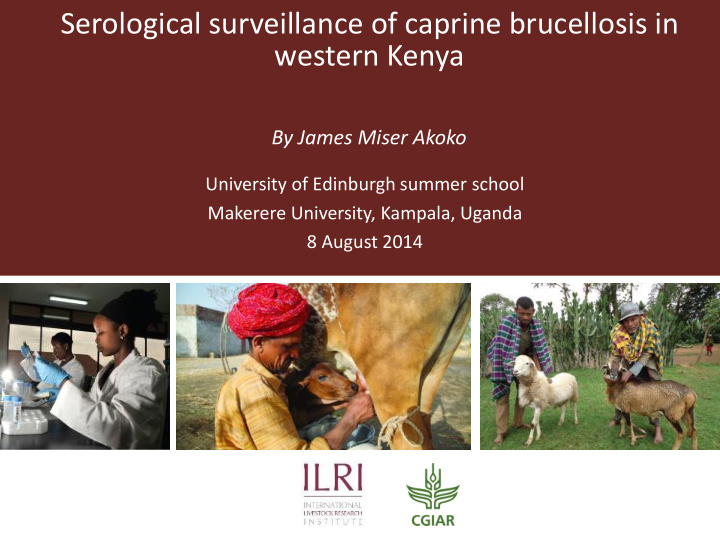



Serological surveillance of caprine brucellosis in western Kenya By James Miser Akoko University of Edinburgh summer school Makerere University, Kampala, Uganda 8 August 2014
Presentation outline People, Animals and their Zoonoses project Brief overview of brucellosis in Kenya Serological survey of caprine brucellosis in western Kenya
Pending question from earlier presentation Brucellosis in camels? Waghela et al. (1978): 172 camels were sampled from Northeastern province. 11 of 172 sera tested reacted in RBPT, 11 in SAT and 21 in CFT. Saudi Arabia 8% prevalence B. melitensis (Radwan 1992)
People, Animals and their Zoonoses (PAZ) project Partners involved: UE, KEMRI & ILRI Study site: western Kenya. www. zoonotic -diseases.org/home/research/paz The caprine brucellosis work was added as a component of the PAZ project. I am very grateful for the opportunity and support offered by Professor Eric Fèvre (PI. PAZ Project) People Peri-domestic animals
Study site
Brucellosis in Kenya According to WHO report, under-reporting of brucellosis in Africa is probably higher than 99%, since almost all diagnosed cases are a result of special studies on the disease (WHO 2011, P.15) Brucellosis persists more in the pastoral systems (Radoz et al. 2013). This is a true reflection in Kenya. Brucellosis recognized as a notifiable disease in 2011. ZDU formed in 2008 to enhance One Health approach and co-ordination
Some of the prevalence studies done in Kenya Author & year of study Sample Place Test (s) Prevalence (%) Namanda (2009) Milk (cattle) Eldoret MRT 0 Waghela et al. (1978) Serum (camel) Northeastern RBT & SAT 6.4 Waghela et al. (1978) Serum (camel) CFC 12.2 Kang’ethe et al. (2000) Milk(cattle) Nairobi ELISA & MRT 4.9 Kiambu ‘’ 3.9 Nakuru ‘’ 2.4 Narok ‘’ 3.4 Waghela (1986) Serum (blue wildebeest) Maasai Mara SAT and CFT 18 Serum (African buffalo) ‘’ ‘’ 30
Brucellosis laboratory data recorded from 2003 to 2010 (Olwande 2013)
Why the study? B. melitensis causes more prolonged, severe and debilitating illness than that caused by B. abortus or B. suis (McDevitt 1973) No data (study) on the role of goats in the epidemiology of brucellosis in western Kenya Farmers in western Kenya are slowly adopting dairy goat rearing, therefore consuming goat milk
Study objectives Estimate the seroprevalence of caprine brucellosis in western Kenya Assess the spatial distribution of the sero-positive cases of caprine brucellosis in western Kenya Assess the risk factors associated with the transmission of brucellosis
Sample size calculation
Sampling design Division Since we had no sampling frame, the number of households to be sampled per sub-location depended on the divisional livestock population. E.g. sub- locations falling in highly populated livestock divisions were given more households than those with lower populations Sub-location GPRS to select households Household Goats - questionnaire and jugular blood collection
Pictorial presentation of data collection and laboratory sample processing Data collection/tecording in hand palm computer Data analysis
Laboratory work 1. Sample 5.Confirmatory recording testing (ELISA) at the lab 2. Centrifuged 4. Test at 3000 rpm using RBT for 20 minutes 3.Kept at -20°C
Results Key: Dots represent the sampled households Map of Kenya Map showing the location of the sampled households
Results contd. A total of 412 homesteads were selected for sampling 27% (112/412) of the selected households kept goats 4.29% goats sampled had experienced abortion Rose Bengal Test: No positive results (n = 355)
Discussion & conclusion The RBT results gave a prevalence of zero, suggesting that goats in western Kenya may be free from B. melitensis. Since RBT has a sensitivity of 80.2% and a specificity of 99.6%, unlike ELISA that has specificity of 92.9% and is 99.6% specific(Rahman et al. 2013), there is need for this result to be confirmed with ELISA to rule out the 19.8% chance of a false negative. We will therefore use ELISA to confirm the results before making a final conclusion of this result. There is need for regular surveillance and education on the prevention and control of brucellosis to reduce or avoid the risk of transmission in animals and people.
Parting shot • Goats can easily pass zoonotic infections due to their close interaction with people • Let’s join hands in controlling brucellosis for a better future!
Acknowledgements This work was financed by It is implemented in partnership with
Thank you better lives through livestock ilri.org The presentation has a Creative Commons licence. You are free to re-use or distribute this work, provided credit is given to ILRI.
Recommend
More recommend